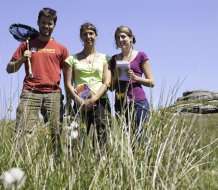Researchers identify wildlife refugia in Dartmoor National Park

Researchers from the University of Exeter are surveying Dartmoor to identity places that shelter wildlife from climate change.
Known as 'refugia', these areas could offer a home to wildlife forced to leave its usual habitat by climate change. Working with Natural England and other partners, researchers from the University of Exeter aimed to discover where such 'refugia' might exist in the wider English landscape.
Dartmoor was shown to be one of the top refugia locations for species such as the Green Hairstreak butterfly (Callophrys rubi) and the unusual carnivorous plant, the Round-leaved Sundew (Drosera rotundifolia). The University of Exeter researchers have subsequently been undertaking the field survey on Dartmoor to confirm the refugia value of the National Park, and to better understand the species using it and why.
The recently-published 'Terrestrial Biodiversity Climate Change Impacts Report Card', coordinated by Natural England, showed that the natural environment in the UK is already being affected by climate change with many species moving northwards to cooler, more suitable habitats. There is concern that some species will not be able to keep up with the pace of climate change. Refugia could therefore play a key role in protecting species from the worst of the changes.
The refugia project is being led by Dr Ilya Maclean and Dr Andrew Suggitt from the University of Exeter's Environment and Sustainability Institute which is based on the Cornwall campuses. They have been assisted in the field survey by a group of student researchers. Julien Marcetteau is studying for an MSc in Ecology, Evolution and Conservation at Imperial College, and Pauline Jorieux and Alizée Dordolo are both undertaking Veterinary programmes at L'Ecole Nationale Vétérinaire de Toulouse, France.
Speaking of the Dartmoor survey, Dr Andrew Suggitt said: "The rich variety of habitats on Dartmoor means that the National Park is already helping wildlife respond to climate change. Dartmoor provides a diversity of so-called 'microclimates' that can help wildlife escape from hot or dry conditions. The large areas of wet upland to the west, together with the ancient East Dartmoor Woods and Heaths, all provide local opportunities for wildlife to escape to cooler or wetter conditions. We need to prioritise these habitats when we devise conservation plans for climate warming."
Data from the Dartmoor field survey will be used to inform Natural England's conservation strategies, which aim to make wildlife more resilient to climate change.
Speaking about the project, Dr Nicholas Macgregor of Natural England said: "This is a very important and promising area of research. One of the priorities for future conservation will be to identify the places where species are likely to be able to persist in the face of changing conditions. The concepts of microclimate and refugia will be an important part of planning conservation under climate change. The University of Exeter and the other organisations involved in this project have done some excellent work to help us identify where the most important potential refugia might be across England."
Provided by University of Exeter



















